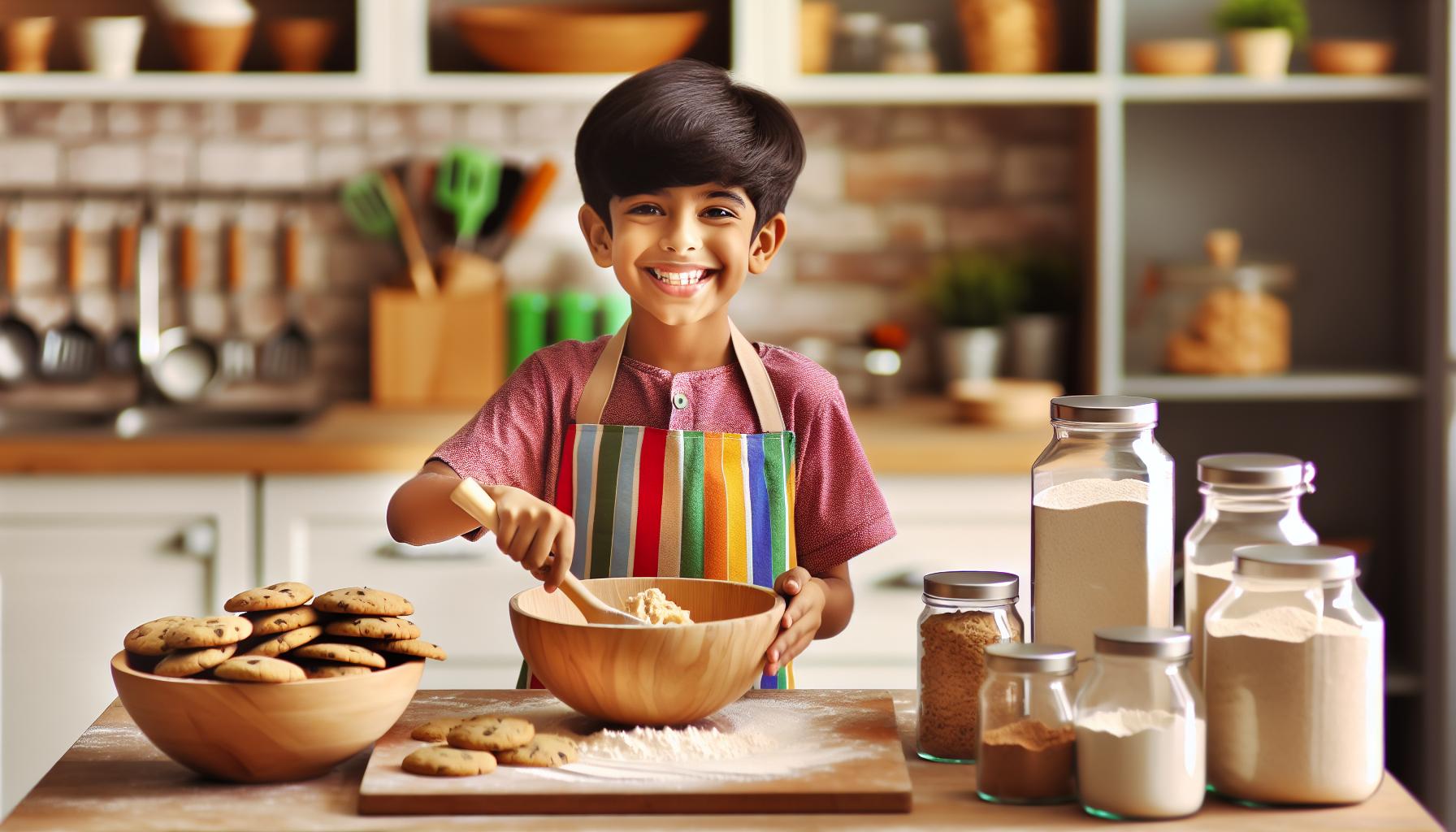
Baking with whole grains can spark joy and creativity in children while teaching them valuable life skills and healthy eating habits. We’ve learned that getting kids involved in the kitchen not only creates lasting memories but also helps them develop a natural appreciation for wholesome ingredients.
The process doesn’t have to be complicated or messy. With pre-measured ingredients and clear step-by-step instructions, kids can focus on the fun parts of baking while learning about nutrition. Whether you’re making whole wheat muffins or oat-filled cookies, these baking activities offer perfect opportunities to bond with your little ones. Want to know how to make whole grain baking an exciting adventure for your family?
Key Takeaways
- Whole grain baking with kids combines fun activities with valuable nutritional education, offering 3x more fiber and essential nutrients than refined grains
- Children develop lasting food preferences between ages 3-12, making early exposure to whole grain baking crucial for establishing healthy eating habits
- Age-appropriate tasks range from simple mixing for 3-5 year olds to independent baking for 9-12 year olds, helping build confidence and kitchen skills
- Essential kid-friendly tools like child-sized equipment and safety gear make whole grain baking both safe and enjoyable
- Different whole grain flours (like white whole wheat, spelt, and oat) offer unique flavors and textures, allowing kids to experiment while maintaining nutritional benefits
Benefits of Whole Grain Baking for Children
Baking with whole grains offers children essential nutrients while teaching them about healthy ingredients. The hands-on experience creates positive associations with nutritious foods through engaging activities.
Nutritional Advantages
Whole grain baking provides critical nutrients for growing children’s development. Here’s what whole grains deliver:
- Contains 3x more fiber than refined grains
- Packs essential B vitamins like thiamin, riboflavin, niacin
- Delivers minerals including iron, zinc, magnesium
- Provides plant-based protein for sustained energy
- Includes antioxidants that support immune health
| Nutrient | Whole Wheat Flour (1 cup) | White Flour (1 cup) |
|---|---|---|
| Fiber | 13g | 3g |
| Protein | 16g | 12g |
| Iron | 4.5mg | 2mg |
| Zinc | 2.8mg | 0.7mg |
Building Healthy Habits Early
Children develop lasting food preferences between ages 3-12. Involving kids in whole grain baking creates positive behaviors:
- Teaches ingredient recognition of nutritious foods
- Develops appreciation for natural flavors
- Creates comfort with whole grain textures
- Establishes connections between ingredients and meals
- Forms positive memories around healthy cooking
- Builds confidence in making nutritious choices
- Measure whole grain ingredients
- Mix batters and doughs
- Shape cookies and rolls
- Decorate finished products
- Sample their healthy creations
Essential Tools and Equipment for Kid-Friendly Baking

Creating a safe baking environment for kids starts with having the right tools at hand. Here’s a comprehensive guide to essential equipment that makes whole grain baking both safe and enjoyable for young bakers.
Basic Kitchen Tools
Kid-friendly baking requires tools that are appropriately sized and easy to handle. Here’s what to keep within reach:
- Measuring cups with clear markings for accurate ingredient portions
- Plastic mixing bowls that resist breaking if dropped
- Silicone spatulas in bright colors for scraping bowls clean
- Child-sized rolling pins for working with whole grain dough
- Non-slip mixing spoons with comfortable grips
- Clear measuring spoons with large handles
- Sturdy whisks sized for small hands
- Cookie cutters in basic shapes
- Non-stick baking sheets with raised edges
- Cooling racks that sit flat on countertops
- Heat-resistant oven mitts sized for children
- Non-slip step stools for reaching countertops
- Aprons to protect clothes from spills
- Safety glasses for protection during mixing
- Timer with large display numbers
- First aid kit stored nearby
- Fire extinguisher in an accessible location
- Non-skid shelf liner for stabilizing mixing bowls
- Rubber-grip potholders for handling warm pans
- Hair ties or caps for keeping hair secured
| Safety Item | Purpose |
|---|---|
| Heat-resistant mitts | Prevents burns from hot surfaces |
| Non-slip stools | Reduces fall risk by 75% |
| Safety glasses | Protects eyes from splashes |
| Hair restraints | Maintains food hygiene standards |
Best Whole Grain Flours for Baking with Kids

Selecting the right whole grain flours makes baking with kids both nutritious and enjoyable. Each type offers distinct textures and flavors that create delicious baked goods while maintaining essential nutrients.
Wheat and Spelt Options
- White Whole Wheat Flour: A mild-flavored flour perfect for kid-friendly recipes like cookies muffins
- Traditional Whole Wheat Flour: Creates hearty textures in breads pizza dough
- Spelt Flour: Offers a sweet nutty taste that works great in pancakes scones
- Sprouted Wheat Flour: Contains more available nutrients making it ideal for breakfast treats
| Flour Type | Best Used For | Kid-Friendly Features |
|---|---|---|
| White Whole Wheat | Cookies Muffins | Light color mild taste |
| Traditional Whole Wheat | Breads Pizza | Rich flavor chewy texture |
| Spelt | Pancakes Scones | Natural sweetness easy mixing |
| Sprouted Wheat | Quick Breads | Enhanced nutrition light texture |
- Oat Flour: Creates tender baked goods with a subtle sweet flavor
- Brown Rice Flour: Blends easily with other flours for varied textures
- Buckwheat Flour: Adds rich nutrients dark color to pancakes waffles
- Quinoa Flour: Provides complete protein perfect for protein-rich snacks
| Gluten-Free Flour | Nutrients | Best Applications |
|---|---|---|
| Oat Flour | Fiber Beta-glucans | Cookies Muffins |
| Brown Rice Flour | B vitamins Minerals | Basic breads Cakes |
| Buckwheat Flour | Protein Antioxidants | Pancakes Crepes |
| Quinoa Flour | Complete Protein Iron | Energy bars Breads |
Simple Whole Grain Recipes to Start With
These beginner-friendly whole grain recipes create perfect opportunities for kids to practice their baking skills. Each recipe features simple steps that children can follow with minimal assistance.
Breakfast Muffins
Whole grain breakfast muffins combine nutrition with hands-on fun in the kitchen. Here’s a basic recipe kids love to make:
Ingredients:
- 2 cups white whole wheat flour
- 1/2 cup honey
- 2 ripe bananas
- 1/3 cup coconut oil
- 2 eggs
- 1 teaspoon vanilla extract
- 1/2 teaspoon cinnamon
Kid-Friendly Steps:
- Mash bananas in a large bowl
- Mix wet ingredients together
- Add dry ingredients one at a time
- Scoop into muffin tins
- Sprinkle toppings like oats or nuts
Kids can customize their muffins with mix-ins such as blueberries, chocolate chips or dried fruit. The recipe yields 12 muffins ready in 25 minutes at 350°F.
Oatmeal Cookies
Oatmeal cookies offer an excellent introduction to whole grain baking for kids. Here’s a simple recipe:
Ingredients:
- 2 cups rolled oats
- 1 cup whole wheat flour
- 1/2 cup brown sugar
- 1/2 cup butter
- 1 egg
- 1 teaspoon vanilla
- 1/2 teaspoon baking soda
- Cream butter and sugar
- Add egg and vanilla
- Mix in dry ingredients
- Roll dough into balls
- Press flat with fork tines
This recipe makes 24 cookies baked at 350°F for 12 minutes. Kids can add raisins, nuts or cinnamon to create their own cookie variations.
Baking temperatures and times stay consistent for both recipes, making them easy for kids to remember.
Teaching Kitchen Skills Through Whole Grain Baking
Whole grain baking creates opportunities for kids to learn essential kitchen skills while having fun. The hands-on experience of measuring ingredients and following recipes helps develop confidence and competence in the kitchen.
Age-Appropriate Tasks
Kids of different ages master specific baking tasks based on their developmental abilities:
Ages 3-5:
- Pouring pre-measured ingredients into bowls
- Stirring dry ingredients with a wooden spoon
- Adding mix-ins like chocolate chips or dried fruit
- Helping to grease baking pans
Ages 6-8:
- Measuring dry ingredients with cups and spoons
- Cracking eggs into a separate bowl
- Kneading whole grain dough
- Operating a hand mixer with supervision
Ages 9-12:
- Reading recipes independently
- Converting measurements
- Operating stand mixers
- Removing baked goods from the oven with proper mitts
Key Baking Techniques
Essential baking skills create a foundation for success in the kitchen:
Measuring:
- Level dry ingredients with a straight edge
- Use clear liquid measuring cups at eye level
- Pack brown sugar firmly in measuring cups
- Spoon flour into cups instead of scooping
Mixing Methods:
- Combine dry ingredients first
- Fold wet ingredients gently into dry
- Mix until ingredients are just combined
- Recognize proper dough consistency
- Preheat ovens completely before baking
- Check doneness with toothpick tests
- Rotate pans halfway through baking
- Cool baked goods on wire racks
Each technique builds upon the previous skill, creating confident young bakers who understand the science behind successful whole grain recipes.
Making Whole Grain Baking Fun and Educational
Whole grain baking offers endless opportunities for children to learn while creating delicious treats. Pre-measured ingredients paired with clear instructions create an engaging experience that builds confidence in young bakers.
Creative Recipe Adaptations
Transform classic recipes into whole grain versions by experimenting with different flour combinations. Add dried fruits like raisins apples cranberries to whole grain muffins or incorporate nuts seeds into cookie dough for extra texture nutrition. Here’s how to make creative adaptations:
- Replace white flour with whole wheat flour in 25% increments
- Mix oat flour into pancake batter for a nutty flavor
- Add ground flaxseed to boost nutrition in quick breads
- Create colorful toppings using natural ingredients like berries coconut
| Whole Grain Flour | Best Uses | Kid-Friendly Features |
|---|---|---|
| White Whole Wheat | Cookies Muffins | Mild flavor Light texture |
| Oat Flour | Pancakes Waffles | Natural sweetness |
| Spelt Flour | Pizza dough Breads | Easy to knead Shape |
| Brown Rice Flour | Crispy treats | Good for beginners |
Learning Opportunities
Baking with whole grains teaches children valuable skills through hands-on activities:
- Math skills through measuring ingredients scaling recipes
- Science concepts like fermentation leavening agents
- Reading comprehension following recipe instructions
- Fine motor development kneading rolling shaping dough
- Chemistry basics observing ingredient reactions
Children develop these practical skills:
- Reading ingredient labels
- Converting measurements
- Understanding kitchen safety
- Practicing time management
- Learning food science principles
Through active participation children discover:
- How different grains affect texture taste
- Why ingredients react together
- What makes baked goods rise
- How temperature changes food
Each baking session becomes an interactive classroom where children absorb knowledge naturally through engaging activities.
Conclusion
Baking with whole grains alongside our children opens up a world of possibilities for creating healthier treats and lasting memories. We’ve seen how this activity goes beyond just making delicious food – it’s about building confidence teaching essential life skills and fostering healthy eating habits that’ll last a lifetime.
By equipping our kids with the right tools knowledge and enthusiasm for whole grain baking we’re setting them up for success in the kitchen and beyond. Let’s embrace these precious moments of learning and discovery while nurturing their natural curiosity about wholesome ingredients and healthy cooking.
Frequently Asked Questions
What age can children start baking with whole grains?
Children can start participating in baking activities as early as age 3, with age-appropriate tasks. Younger children can help with simple tasks like pouring pre-measured ingredients and mixing, while older children can take on more complex responsibilities. The key is to assign tasks based on their developmental stage and motor skills.
Why is baking with whole grains better than using refined flours?
Whole grains contain three times more fiber than refined grains and are packed with essential nutrients like B vitamins, minerals, protein, and antioxidants. They provide better nutrition for growing children and help establish healthy eating habits early in life.
What are the basic tools needed for baking with kids?
Essential tools include child-sized measuring cups and spoons, mixing bowls, rolling pins, heat-resistant oven mitts, non-slip step stools, and safety glasses. Having appropriately sized tools makes the experience safer and more enjoyable for young bakers.
How can baking teach children important life skills?
Baking teaches various skills including math (through measuring), science (understanding chemical reactions), reading (following recipes), and fine motor skills (mixing and decorating). It also builds confidence, creativity, and understanding of nutrition and healthy ingredients.
What are the best whole grain flours for beginners?
White whole wheat flour is ideal for beginners as it has a milder taste than traditional whole wheat while maintaining nutritional benefits. Other beginner-friendly options include oat flour and spelt flour. These flours work well in simple recipes like muffins and cookies.
How can I make whole grain baking fun for kids?
Let children choose mix-ins like dried fruits or nuts, use cookie cutters for shapes, and allow them to decorate their creations. Make it interactive by asking questions about ingredients and processes. Keep sessions short and focus on the enjoyment rather than perfection.
Are there gluten-free whole grain options for baking?
Yes, there are several gluten-free whole grain options including oat flour (certified gluten-free), brown rice flour, buckwheat flour, and quinoa flour. These can be used individually or in combinations to create delicious baked goods.
How do I ensure safety while baking with children?
Always supervise children, establish clear safety rules, use appropriate safety equipment, and teach proper hand washing. Keep hot surfaces out of reach, use child-safe tools, and ensure the workspace is clean and organized.

